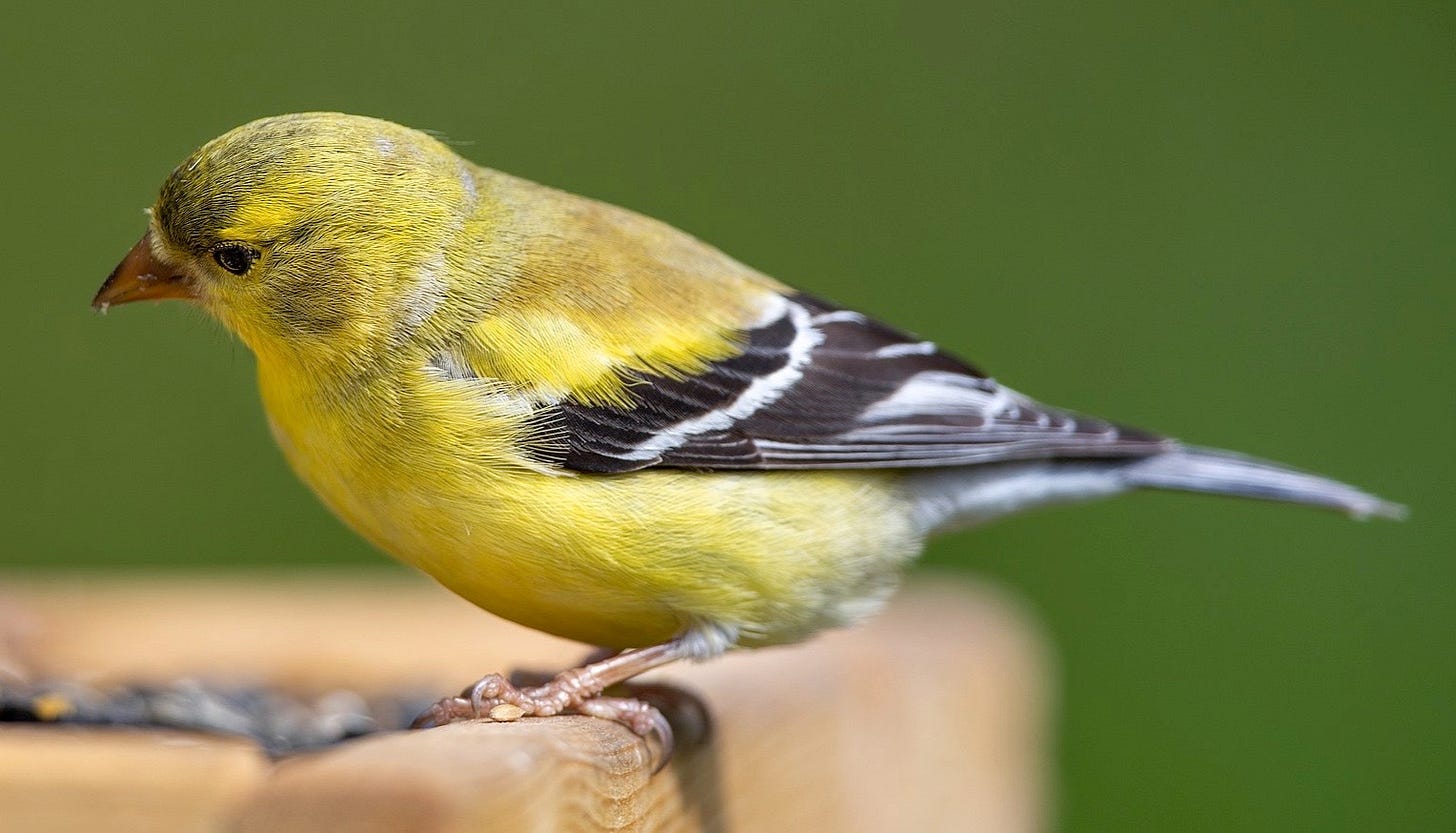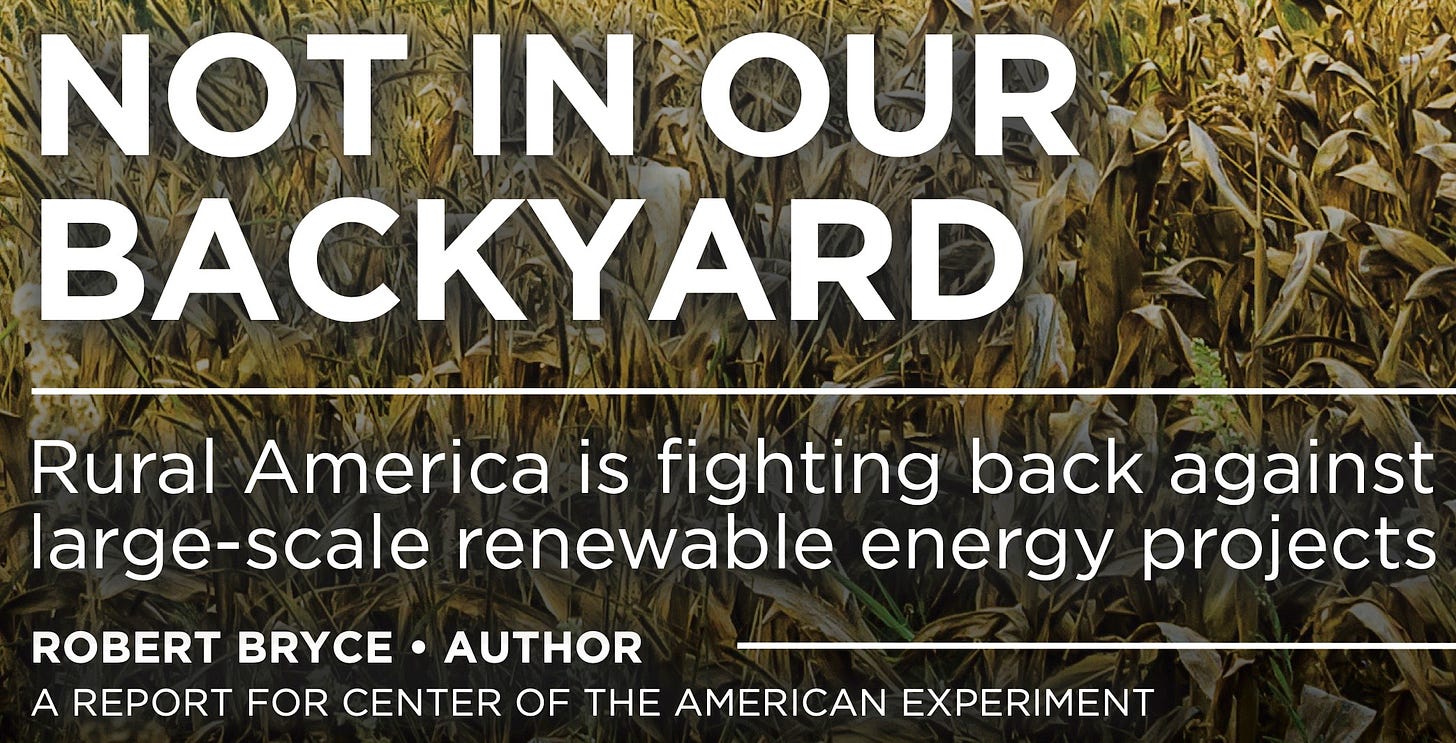Isaac Orr on the podcast, American Goldfinches in Roseville
Isaac Orr talks mining and minerals on the podcast, a pair of American Goldfinches in the Twin Cities
Today’s the last day of travel for a while. Lorin and I are in Stillwater, Minnesota, where it’s about 20 degrees cooler than it is in Austin. We've enjoyed the break from the summer heat in Texas. I’ve done three presentations this week. On Tuesday, I was in Columbus, Ohio, where I spoke to Ohio’s Electric Cooperatives about the many regulatory and political challenges facing coops under the Biden Administration. (Ohio has 25 electric coops and they are heavily dependent on coal-fired power plants.) Yesterday, I did two presentations here in Minnesota with my friends at the Center of the American Experiment. At a lunch event in Albert Lea, a town near the Minnesota-Iowa border, Isaac Orr (see more about him below) and I did a tag-team presentation on renewable energy. Isaac focused on the mining, minerals, and waste issues of solar and wind. My presentation focused on my recent report, “Not In Our Backyard,” which was published by the Center in April. In addition to providing updates on the report – the latest tally: since 2015, 312 government entities from Maine to Hawaii have rejected or restricted wind projects – I also discussed grid resilience, wildlife impacts, and the human health problems caused by the low-frequency noise and infrasound that is produced by wind turbines.
Isaac and I reprised our presentations at a second event last night in the Twin Cities. We had a large crowd, with about 250 people attending. It was great fun to have such a large and appreciative audience. John Hinderaker, the president of the Center of the American Experiment, was a great host for the two events and the team at the Center did a fine job of arranging both events.
Okay, that’s a sufficient update on our travels. We are in a too-small hotel room and are heading to the airport in a few minutes, so I’m going to keep this email note short. Two items today:
Isaac Orr on the podcast: “conservation comes after breakfast”
American Goldfinches in Roseville
Photo above is a male American Goldfinch.


Isaac Orr on mining, coal-fired power, and the mineral-intensity of wind and solar energy
On this week’s episode of the Power Hungry Podcast, (number 67) Isaac Orr describes himself as “a farm kid from Wisconsin who got wrapped up in energy and environmental politics or policy.” His experience on the farm shaped his worldview: “when you grow up on a farm, you have a lot of, you know, self-sufficiency that’s built into you...you want to work hard and keep what you earn, right. And for us, it’s really about stubbornness and independence.”
Isaac is a policy fellow at Center of the American Experiment, a Minnesota-based think tank, where he writes about environmental issues, mining, and electricity policy. Among his most-cited research is the 2019 report, “Doubling Down on Failure.” In this episode, Isaac and I talked about a range of issues including mining in Minnesota, the importance of coal-fired electricity in the state, and his forthcoming report on the material intensity of various forms of electricity production.
Isaac’s work on minerals and mining is important and timely. He pointed out that if Minnesota attempted to meet its total energy needs using wind and solar, it would require about 3% of all of the world’s copper production. It would also massive amounts of other minerals, including cobalt and nickel. But by relying on developing countries to mine those commodities, the US will be exporting “the environmental impacts of renewable energy development to the developing world” he said, where the enforcement of environmental regulations is either weak or non-existent. “That’s why it’s important for us to mine things domestically, because, you know, that’s where we’re going to take the most care of the environment.”
He continued, saying “conservation comes after breakfast...if you are not economically or financially secure, the environment is going to be a secondary concern...The environment becomes a priority after you have a certain baseline of economic stability and quality of life to where, you know, the next step on that ladder to increasing quality of life is improving the environment.”
I have talked to Isaac by phone several times over the past few years. It was fun to share the stage with him in Albert Lea and the Twin Cities and it was a treat to have him on the podcast. Click here to listen to the episode and if you like it, please share it.

Spinus tristis, male and female, in Roseville
On Wednesday afternoon, after a meeting in the Twin Cities, I had an extra hour or two, so I went for a leisurely birding walk in Central Park, a lovely park in Roseville, a suburb north of St. Paul. Minnesota is filthy with ponds and lakes, and Central Park is no exception. A smooth asphalt path circled one of the lakes in the park so I ambled along that path, happy to be outside on a sunny day. Some ducks were in the middle of the lake, but they were too far away to identify. (And my duck identification skills are not that good.) A single Reddish Egret was patrolling the shore. I like Egrets, but Reddish Egrets are common along Barton Creek in Austin, so I didn’t pay it too much attention.
A short while later, I heard a pair of birds singing overhead and soon spotted a pair of American Goldfinches (Spinus tristis), a male and a female. I was happy to see them for several reasons. The two birds were close by, moving around the shore less than 10 feet away and they weren’t in a hurry. That meant I could get a good look at them through my binoculars. The male is colorful, with a bright yellow body that is offset by a black skull cap and black wings with white stripes. Seeing it through binoculars is a treat. In addition, the male and the female (photo immediately above) were perched close to each other so I could compare them without having to move my field of view very much. Finally, we commonly see Lesser Goldfinches in Austin. American Goldfinches, not so much. Thus, I was happy to be rewarded for bringing my binoculars along on this trip.
Wikipedia has this description of the American Goldfinch:
The only finch in its subfamily to undergo a complete molt, the American goldfinch displays sexual dichromatism: the male is a vibrant yellow in the summer and an olive color during the winter, while the female is a dull yellow-brown shade which brightens only slightly during the summer. The male displays brightly colored plumage during the breeding season to attract a mate. The American goldfinch is a granivore and adapted for the consumption of seedheads, with a conical beak to remove the seeds and agile feet to grip the stems of seedheads while feeding... Human activity has generally benefited the American goldfinch. It is often found in residential areas, attracted to bird feeders which increase its survival rate in these areas. Deforestation also creates open meadow areas, which are its preferred habitat.
Have a good weekend.
Want to help?
1. Share this email to your friends and colleagues. Or have them email me so I can add them to my distribution list.
2. Subscribe to the Power Hungry Podcast.
3. Rent or buy Juice on iTunes or Amazon Prime.
4. Buy A Question of Power: Electricity and the Wealth of Nations and give it a positive review.
5. Follow me and Juice on Twitter.
6. Need a speaker for your conference, class, or webinar? Ping me!
Thanks!

Share this report
I have been pleased with the response to my recent report about land-use conflicts and renewables. "Not In Our Backyard," was published on April 21 by the Center of the American Experiment. The center is also the home of the Renewable Energy Rejection Database, which includes details on the 312 local, regional, and state governments that have rejected or restricted wind-energy projects since 2015. Here's a link to the full report. Please share it.
Watch Juice for free on Roku!
If you haven't seen our documentary yet, here's a reminder: you can watch Juice: How Electricity Explains the World, on Roku, for free. Just click this link. If your friends haven't seen it, send them a link. Or if you have a prime membership, you can watch it on Amazon Prime.



